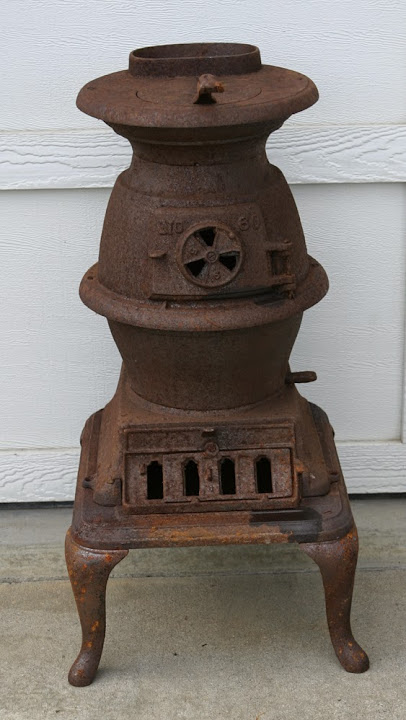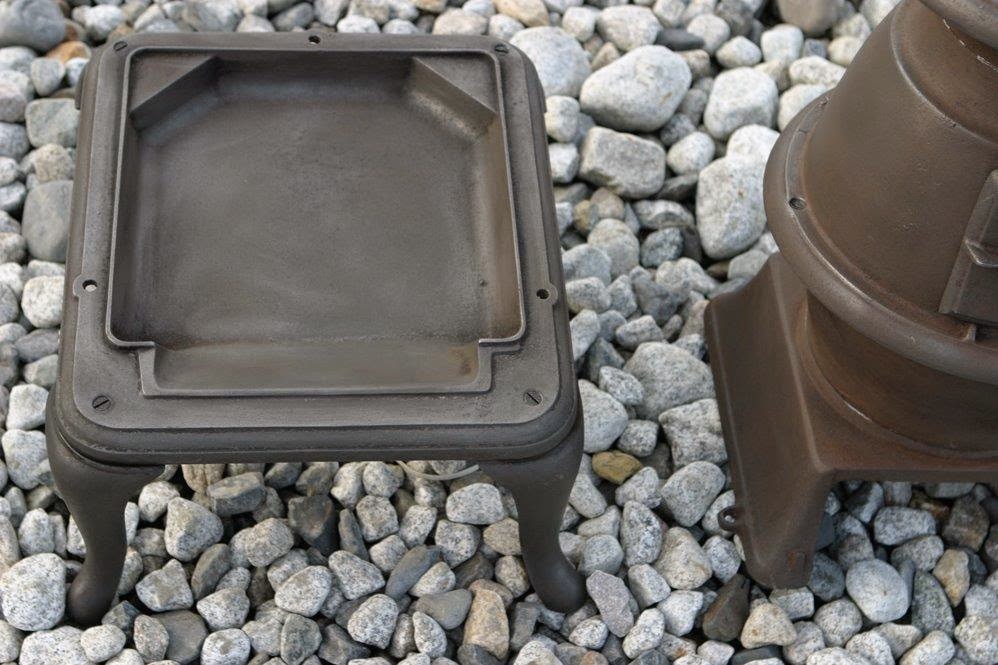-
If a web search for the answer to your cast iron cookware question has brought you directly to this forum, the information you seek may be covered in one of the many reference topics featured on the main website.
Quick Links: · Main Website · How to Identify Unmarked Pans · All About Cleaning & Seasoning · Reproductions & Counterfeits · Commonly-Used Terms
You are using an out of date browser. It may not display this or other websites correctly.
You should upgrade or use an alternative browser.
You should upgrade or use an alternative browser.
Using NaOH for electrolyte
- Thread starter ShawnE
- Start date
Jeffrey R.
Well-known member
Fair enough. It's still probably less concentrated than your lye tank. Treat both of them with respect and you should be fine. Whatever works for you. Snow & ice sucks. Kinda of glad I had to move here many years ago after growing up in Wisconsin.
Safety is first with every thing that I do. You only have to get it wrong once.
It would not be wise to steal a piece of cast iron out of my lye tank, you just might come out without skin on your hand. :laughup:
Snow is good = water, something you out in dry land know all to much about. Make sure the water police do not catch you.:covri:
Jeffrey R.
Well-known member
Snow is good = water. True, but I don't have to shovel rain. :chuckle:
From what we here, you would just need a sponge, shovel just to big.
I decided to document a test that I did today. It took 3 Hrs from as found condition to ready to season. It's seasoning right now.
2:15 in e-tank. 2.5% NaOH, 13A. this is about 10 mA / cm2
0:15 scrubbing under cold water rinse with plastic brush and 0000 steel wool
0:30 oven dry at 200F
2:15 in e-tank. 2.5% NaOH, 13A. this is about 10 mA / cm2
0:15 scrubbing under cold water rinse with plastic brush and 0000 steel wool
0:30 oven dry at 200F
Last edited:
Better link to pictures
https://picasaweb.google.com/105980170291882110053/Wagner8NaOHETankCleaning#6132187594504065874
https://picasaweb.google.com/105980170291882110053/Wagner8NaOHETankCleaning#6132187594504065874
Jeffrey R.
Well-known member
Looks good from here. :icon_thumbsup:
I had to pull my stove from my E-tank, with temps in the 20s and snowing. 90% of the stove is rust free. I added 3 more lbs of lye also. Still no corrosion detectable on my steel anodes, just might not need the carbon plates.
I had to pull my stove from my E-tank, with temps in the 20s and snowing. 90% of the stove is rust free. I added 3 more lbs of lye also. Still no corrosion detectable on my steel anodes, just might not need the carbon plates.
Jeffrey R.
Well-known member
10 Lbs, perfect. What current are you running? Again, any anode erosion???
I started up my E-tank after a cold spell and 2" of ice on the top. So the sun came out and the temps hit 66 deg. In went the stove to finnish. I think I have 8 hours on the top part of the stove, but part of that time I was using a smaller amount of lye. It does seem to work faster with 10 lbs in 55 gallons now. I will push it to 12 lbs. next run, but it is snowing and 32 deg. today.
The current I am using; 12 volt @ 10 amp I did push it to 12 volt @ 30 amp, but blew a fuse.
Anode erosion? None, clean.
The next question would be, if this set up will work faster / better using graphite plates??
A little History: I have been told by a member of the estate where this stove came from. That this BRS stove came from a train car on the Grand Trunk Railway, that ran in and out of the island Pond, VT railway Station. I also picked up two shovels that were used to shovel coal on the trains.
Before.

After 8 hours.

The base after 5 hours. The lye was stronger at this point.

Did get a little flash rust on the top part of the stove. Next day the sun comes out, I will put it in for one more hour.
The only hard part with doing large items in the tank. You do get lye on your clothes. With skillets, will be no problem.
Fumes, I did smell something, so stay clear.
It looks like it's cleaning up pretty good. :icon_thumbsup: Anode size and spacing does play a role in how quickly the process works, and how evenly you remove the rust. This is why I'm trying 26 Ga (0.030") sheet steel. It is flexible enough to bend by hand. If all works out, I plan on lining all sides of my final tank with it. I doubt that your cell (e-tank) actually has 12V across it, which is why you blew a fuse at the 30A setting. In my test cell I tend to get between 4V to 6V across the cell at 20A depending on workpiece size and spacing to the anodes.
One thing that you could do it to wire up a standard household dimmer circuit to run your charger off of. This would allow you to adjust the current. Most simple manual chargers are nothing more than a transformer, diode bridge, and a meter. The "current switch" just changes taps on the transformer. I would probably just get a double wide metal electrical box, a dimmer and an outlet. You can get face plates that will accommodate this setup. Wire up a cord to this and you have an adjustable outlet. This way you can set the charger to the highest setting and adjust the actual current with the dimmer.
About splashing, yes you do have to be careful with the larger pieces, just make haste more slowly and as always when working with chemicals, proper personal protection is recommended.
and as always when working with chemicals, proper personal protection is recommended.
One thing that you could do it to wire up a standard household dimmer circuit to run your charger off of. This would allow you to adjust the current. Most simple manual chargers are nothing more than a transformer, diode bridge, and a meter. The "current switch" just changes taps on the transformer. I would probably just get a double wide metal electrical box, a dimmer and an outlet. You can get face plates that will accommodate this setup. Wire up a cord to this and you have an adjustable outlet. This way you can set the charger to the highest setting and adjust the actual current with the dimmer.
About splashing, yes you do have to be careful with the larger pieces, just make haste more slowly
Jeffrey R.
Well-known member
I doubt that your cell (e-tank) actually has 12V across it, which is why you blew a fuse at the 30A setting.
I agree. That was the setting that I was on when it kicked the fuse. My charger is a 6 volt and also a 12 volt charger.
I am on the hunt for 2 more long anodes. I think that will help a lot.:icon_thumbsup:
Jeffrey R.
Well-known member
ShawnE, I will say this, I am most impressed how my E-tank is cleaning my cast iron. My NaOH water is still clean. Only thing I will do to it is add 2 more long anodes.:icon_thumbsup:
How are you doing with yours?
How are you doing with yours?
My little test cell works great. I built it in a 9 gal wastebasket that I had laying around. I'm using 4 22 Ga mild steel sheets as anodes. It is reconfigurable for any combination from 1 side to all 4. I use it as a combination lye and e-tank at the same time. I can drop an as found pan in and within 2 - 3 Hrs it is stripped to bare metal. I'll never go back to washing soda. The anodes stay clean. I'll post pictures in the not too distant future. I've got a bunch of Honey-Do projects this weekend.
Ok, finally got around to firing up the new test cell. 1 pan done, 2nd is in the tank. They go from as found to stripped in the tank. Here are some pictures, I'll add to them as I run all 6 test pieces through them. 2 lbs NaOH in ~8.5 gal H20 as electrolyte / lye bath.
https://picasaweb.google.com/105980170291882110053/CastIron02#6138084356065412082
https://picasaweb.google.com/105980170291882110053/CastIron02#6138084356065412082
Oooops.... I forgot to make it public. Try the link now. From my limited testing, this is the way to go. I don't use a separate lye tank, I just go from as found to stripped in one go. The down side is there is a fair amount of soap scum on the top. I just skim it off. Lye & fat do make soap.
Yep, working now. Looks like a good result in a short time. I'd be curious how it does with a piece that is heavily caked in crud, where electro seems to struggle a bit with, and the lye bath takes many days even at warmer ambient temps.
I'm glad you featured the iron mountain, because at picture #3 all I could think of was "oooh iron mountain!". I have a soft spot for those
I'm glad you featured the iron mountain, because at picture #3 all I could think of was "oooh iron mountain!". I have a soft spot for those
An extremely crudded up piece might take a couple more hours. One thing that you can do to speed up the process is to remove the piece from the tank after an hour or 2 and give it quick scrub with a stiff plastic brush to loosen up the crud. Then put it back into the tank for further processing. This also lets you gauge the progress.
The beauty of this process is that you get mechanical cleaning due to the H2 bubbling off of the work piece. By using a strong lye solution as your electrolyte you get double duty. Electrolysis by itself will help loosen the bond that the crud has to the metal, as will lye by itself. The 2 in combination seems to work much faster. Synergy in action.
The beauty of this process is that you get mechanical cleaning due to the H2 bubbling off of the work piece. By using a strong lye solution as your electrolyte you get double duty. Electrolysis by itself will help loosen the bond that the crud has to the metal, as will lye by itself. The 2 in combination seems to work much faster. Synergy in action.
